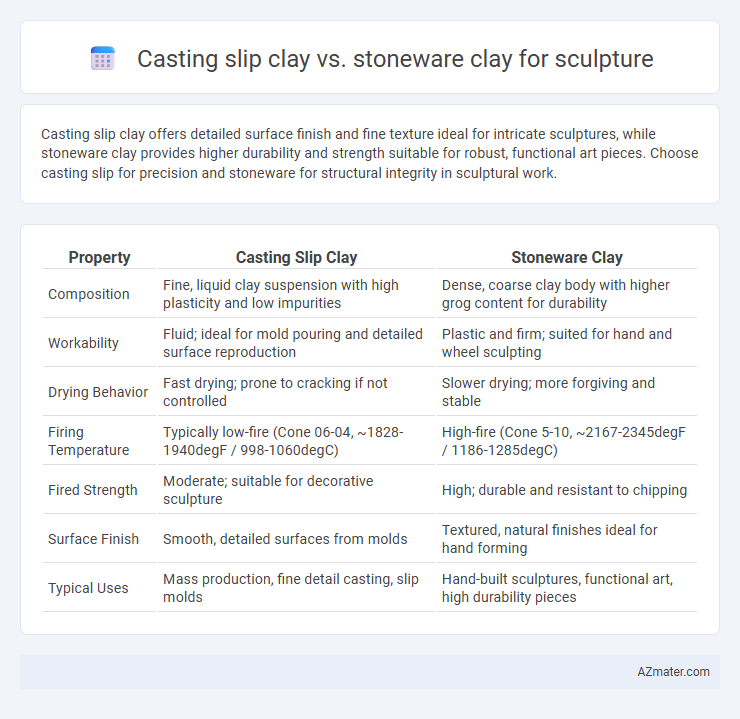Casting slip clay offers detailed surface finish and fine texture ideal for intricate sculptures, while stoneware clay provides higher durability and strength suitable for robust, functional art pieces. Choose casting slip for precision and stoneware for structural integrity in sculptural work.
Table of Comparison
| Property | Casting Slip Clay | Stoneware Clay |
|---|---|---|
| Composition | Fine, liquid clay suspension with high plasticity and low impurities | Dense, coarse clay body with higher grog content for durability |
| Workability | Fluid; ideal for mold pouring and detailed surface reproduction | Plastic and firm; suited for hand and wheel sculpting |
| Drying Behavior | Fast drying; prone to cracking if not controlled | Slower drying; more forgiving and stable |
| Firing Temperature | Typically low-fire (Cone 06-04, ~1828-1940degF / 998-1060degC) | High-fire (Cone 5-10, ~2167-2345degF / 1186-1285degC) |
| Fired Strength | Moderate; suitable for decorative sculpture | High; durable and resistant to chipping |
| Surface Finish | Smooth, detailed surfaces from molds | Textured, natural finishes ideal for hand forming |
| Typical Uses | Mass production, fine detail casting, slip molds | Hand-built sculptures, functional art, high durability pieces |
Introduction: Understanding Casting Slip Clay and Stoneware Clay
Casting slip clay is a liquid form of clay specifically formulated for detailed mold casting and fine surface textures in sculptures. Stoneware clay, known for its durability and high firing temperature, offers a robust medium for hand-building and wheel-throwing larger, functional, or artistic pieces. Understanding the distinct properties and applications of casting slip and stoneware clay helps sculptors select the appropriate material for their desired texture, strength, and finishing techniques.
Composition Differences: Casting Slip vs Stoneware Clay
Casting slip consists primarily of finely ground clay particles suspended in water, allowing for smooth, detailed molds ideal for slip casting techniques. Stoneware clay contains larger, coarser particles along with natural fluxes like feldspar and silica, providing durability and strength after firing but less fluidity for intricate casting. The compositional difference impacts workability and final texture, with casting slip optimized for precision and stoneware clay suited for robust, hand-built sculptures.
Workability: Sculpting Techniques with Both Clays
Casting slip clay offers superior fluidity and fine particle size, allowing for intricate detail and smooth surfaces in sculpting, making it ideal for delicate, thin-walled forms. Stoneware clay has a denser, coarser texture that provides more resistance and plasticity, enabling robust hand-building techniques such as carving, coiling, and slab construction. Workability differences require artists to adapt their sculpting methods: slip clay favors precision and molds, while stoneware supports structural manipulation and textural experimentation.
Drying and Shrinkage Characteristics
Casting slip clay offers a finer particle size and higher plasticity that results in a more even drying process with minimal cracking, making it ideal for detailed sculptures requiring smooth surfaces. Stoneware clay, with its coarser texture and denser composition, tends to shrink more uniformly but at a slower rate, providing durability but requiring careful control to prevent warping during drying. Both materials demand controlled humidity and gradual drying to minimize shrinkage cracks, with casting slip clay typically exhibiting less overall shrinkage compared to stoneware clay.
Firing Temperatures and Thermal Properties
Casting slip clay typically fires at lower temperatures around cone 04 (about 1940degF or 1060degC), resulting in a softer, more porous finish ideal for detailed, delicate sculpture work. Stoneware clay requires higher firing temperatures, usually between cone 5 and cone 10 (2167degF to 2381degF or 1186degC to 1305degC), producing a denser, vitrified material with superior thermal shock resistance and durability. The thermal expansion and contraction rates of stoneware are generally better suited for outdoor sculptures or functional pottery, while casting slip clays are favored for fine, intricate models and decorative pieces.
Surface Finish: Texture and Detail Retention
Casting slip clay offers a smooth surface finish with excellent fine detail retention, making it ideal for intricate sculptural work and delicate textures. Stoneware clay provides a more textured and robust surface, suitable for sculptures requiring a tactile, natural feel and durability. The choice between casting slip and stoneware clay hinges on whether the priority is achieving crisp detail or a rugged, expressive texture.
Durability and Strength in Final Sculpture
Casting slip clay offers fine detail and smooth surfaces but generally results in a more fragile final sculpture due to its porous and less dense nature. Stoneware clay, fired at higher temperatures, produces a significantly stronger and more durable sculpture with greater resistance to chipping and environmental stress. The vitrification process in stoneware enhances structural integrity, making it preferable for sculptures requiring long-term durability and strength.
Suitability for Different Sculptural Styles
Casting slip clay excels in fine detail and smooth textures, ideal for delicate figurative sculptures and intricate designs requiring precision. Stoneware clay, known for its durability and strength, suits larger, robust sculptures where structural integrity and a rustic aesthetic are desired. Artists often choose casting slip for detailed, lightweight works and stoneware clay for bold, textured pieces that withstand handling and environmental stress.
Cost and Accessibility of Clays
Casting slip clay offers a more affordable option for sculptors due to its lower price and ease of bulk production, making it accessible for large-scale or repetitive projects. Stoneware clay, while generally more expensive, provides greater durability and a wider range of textural finishes, often requiring specialized suppliers and higher costs for quality materials. The choice between casting slip and stoneware clay heavily depends on budget constraints and the availability of local suppliers or manufacturers.
Choosing the Right Clay for Your Sculpture Project
Casting slip clay offers exceptional detail capture and smooth finishes, ideal for intricate or delicate sculptures requiring fine textures. Stoneware clay provides greater durability and structural strength, suitable for larger or functional sculptural pieces exposed to varying environmental conditions. Selecting between casting slip and stoneware clay depends on project scale, desired surface texture, and the sculpture's intended use or display environment.

Infographic: Casting slip clay vs Stoneware clay for Sculpture
 azmater.com
azmater.com